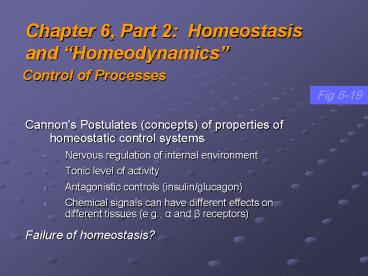Chapter 6, Part 2: Homeostasis and Homeodynamics - PowerPoint PPT Presentation
1 / 23
Title:
Chapter 6, Part 2: Homeostasis and Homeodynamics
Description:
Tonic level of activity. Antagonistic controls (insulin/glucagon) ... Sensory receptor. Peripheral. Central. Membrane receptor ... – PowerPoint PPT presentation
Number of Views:380
Avg rating:3.0/5.0
Title: Chapter 6, Part 2: Homeostasis and Homeodynamics
1
Chapter 6, Part 2 Homeostasis and
Homeodynamics
Control of Processes
Fig 6-19
- Cannon's Postulates (concepts) of properties of
homeostatic control systems - Nervous regulation of internal environment
- Tonic level of activity
- Antagonistic controls (insulin/glucagon)
- Chemical signals can have different effects on
different tissues (e.g., a and ß receptors) - Failure of homeostasis?
2
Modulation of Signal Pathways
Receptors exhibit
- Saturation, yet
- Receptors can be up- or down-regulated (e.g. drug
tolerance) - Change the number of or binding affinity of the
receptor - Specificity, yet
- Multiple ligands for one receptor Agonists
(e.g. nicotine) vs. antagonists (e.g. tamoxifen,
finasteride) - Multiple receptors for one ligand (see Fig 6-18)
- Competition
- Aberrations in signal transduction causes many
diseases (table 6-3) - Many drugs target signal transduction pathway
(SERMs, ?-blockers etc.)
3
Up- vs. Down-regulation
- Up
- ? Receptors (e.g., exocytosis)
- ? Affinity for ligand
- Down (think drug tolerance)
- Add competitors
- Desensitization of receptors
- Intracytoplasmic changes
4
a- and ß-receptors (fig 6-18)
E.g., Specificity
5
In Summary Receptors Explain Why
- Chemicals traveling in bloodstream act only on
specific tissues. - No receptor, no activity
- One chemical can have different effects in
different tissues. - May have or - effect
6
Control Pathways Response and Feedback Loops (p
191)
- Maintain homeostasis
- Local paracrines and autocrines
- Long-distance - reflex control
- Nervous
- Endocrine
- Cytokines
7
Steps of ReflexControl (a review)
Stimulus (internal or external) Sensory
receptor Afferent path Integration
center Efferent path Effector (target
cell/tissue) Response
8
Tonic Control
9
Antagonistic Control
10
Receptors (or Sensors)
- Different meanings for receptor
- Sensory receptor
- Peripheral
- Central
- Membrane receptor
- Endocrine cells act as receptor and effector
- Constantly monitor environment
- External or Internal
- Threshold ( minimum stimulus necessary to
initiate response) - Afferent ? Integration ? Efferent
Fig 6-23
11
New definition!
12
Afferent Pathway
- From receptor to integrating center.
- Same as the Reflex Pathway
- Endocrine system has no afferent pathway
(stimulus comes directly into endocrine cell)
13
Integrating Center
- Neural reflexes usually in the CNS endocrine
integration in the endocrine cell itself - Receives info about change
- Interprets multiple inputs and compares them with
set-point - Determines appropriate response (? alternative
name control center)
14
Efferent Pathway
- From integrating center to effector
- NS ? electrical and chemical signals
- Action Potential
- ACh
- ES ? chemical signals
- hormones
15
Effectors
- Cells or tissues carrying out response
- Target for NS
- Muscles, glands and some adipose tissues
- Target for ES
- Any cell with proper receptor
- May be or -
16
In a feedback loop, effectors that bring about
change receive information from
- a stimulus
- the control center
- receptors
- a response mechanism
17
Responses at 2 levels
- Cellular response of target cell, e.g.,
- opening or closing of a channel
- Modification of an enzyme etc...
- Systemic response at organismal level
- vasodilation, vasoconstriction
- Lowering of blood pressure etc....
18
Feedback Loops Modulate the Response Loop
- Response loop is only half of reflex! ? Response
becomes part of stimulus and feeds back into
system. - Purpose keep system near a Set Point
- E. g., Household thermostat
- Circadian rhythms are changes in setpoint
- Two types of feedback loops
- - feedback loops (homeostatic)
- feedback loops (not homeostatic)
Fig 6-25
19
Homeostasis Dynamic Equilibrium with
Oscillation around Set Point
Fig 6-26
20
Negative and Positive Feedback
NOT homeostatic !!
Homeostatic
21
Negative Feedback Example
22
Feedback Loop
fig 6-28
23
Both insulin and glucagon are peptide hormones
that target liver cells. The response of the
target cells to each of these two hormones is
opposite. This information implies that
- the two hormones bind to different cell surface
receptors. - one hormone binds to a receptor on the cell
membrane and the other to an intracellular
receptor. - each of the two hormones uses a different second
messenger. - both hormones interact with receptors at the cell
nucleus. - A and C
24
Positive feedback loops in models assume that
secondary effects ________ the basic trend, while
negative feedback loops assume that secondary
effects tend to _________ the basic trend.
- counteract reinforce
- reinforce counteract.
- self-limit retard.
- enhance promote.
25
The Bodys 2 Control Systems
- Variation in speed, specificity and duration of
action - The two systems allow for 4 different types of
biological reflexes - Simple (pure) nervous
- Simple (pure) endocrine
- Neurohormone
- Neuroendocrine (different combos)
Fig 6-30
26
NS ES are linked in a continuum
27
(No Transcript)































